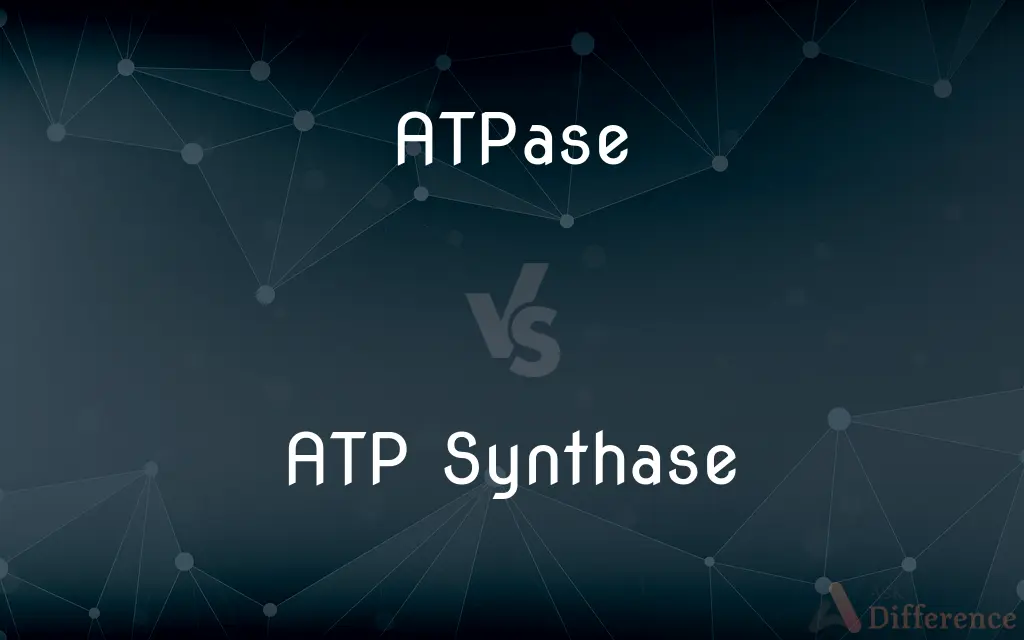ATPase vs. ATP Synthase — What's the Difference?
By Urooj Arif & Fiza Rafique — Published on February 21, 2024
ATPase hydrolyzes ATP into ADP and phosphate, releasing energy, while ATP Synthase synthesizes ATP from ADP and phosphate, utilizing a proton gradient.

Difference Between ATPase and ATP Synthase
Table of Contents
ADVERTISEMENT
Key Differences
ATPase and ATP Synthase are essential enzymes involved in cellular energy transactions, but they function oppositely. ATPases are a broad class of enzymes that catalyze the decomposition of ATP (adenosine triphosphate) into ADP (adenosine diphosphate) and inorganic phosphate, a reaction that releases energy used by the cell for various activities. This group includes various types of enzymes such as Na+/K+-ATPase involved in maintaining cellular ion gradients.
On the other hand, ATP Synthase is a specific enzyme complex found in the mitochondria of eukaryotic cells and in the thylakoid membrane of chloroplasts in plants. It plays a pivotal role in cellular respiration and photosynthesis by synthesizing ATP from ADP and inorganic phosphate. This process is driven by a proton gradient across the membrane, created by the electron transport chain during oxidative phosphorylation or light reactions in photosynthesis.
ATPase activity generally refers to the breakdown of ATP, releasing energy for cellular processes, whereas ATP Synthase activity is synonymous with energy storage, capturing energy in the form of ATP. The direction of the reaction—synthesis or hydrolysis—depends on the specific enzyme and the cellular conditions.
The functions of ATPase and ATP Synthase are reflective of their roles in energy metabolism. ATPases are involved in a wide range of cellular functions, including muscle contraction, nerve impulse transmission, and active transport across membranes. ATP Synthase, however, is central to energy production, providing the ATP necessary for cellular work.
ATPase and ATP Synthase are two sides of the cellular energy coin; ATPases use the energy from ATP hydrolysis to power cellular activities, while ATP Synthase recaptures energy in the form of ATP, completing the cycle of energy flow within the cell.
ADVERTISEMENT
Comparison Chart
Main Function
Hydrolyzes ATP to ADP and phosphate, releasing energy
Synthesizes ATP from ADP and phosphate, using a proton gradient
Energy Role
Utilizes energy from ATP hydrolysis
Captures and stores energy in the form of ATP
Location
Found in various cellular locations, including cell membranes and organelles
Primarily located in the mitochondrial inner membrane and thylakoid membrane of chloroplasts
Types
Includes various types like Na+/K+-ATPase, H+/K+-ATPase
Specifically refers to the enzyme complex involved in oxidative phosphorylation and photosynthesis
Cellular Process
Involved in processes like muscle contraction, nerve impulse, and active transport
Central to cellular respiration and photosynthesis
Compare with Definitions
ATPase
Essential for active transport mechanisms.
ATPases in neuron membranes help re-establish ion gradients after nerve impulses.
ATP Synthase
Operates in the reverse direction of ATPases.
ATP Synthase uses the energy from proton flow to combine ADP and phosphate into ATP.
ATPase
Enzymes that catalyze ATP hydrolysis to release energy.
The Na+/K+-ATPase maintains the cell's ion gradient by hydrolyzing ATP.
ATP Synthase
A complex enzyme that synthesizes ATP using a proton gradient.
ATP Synthase in mitochondria produces ATP during cellular respiration.
ATPase
Involved in various cellular activities.
H+/K+-ATPase in stomach cells aids in acid secretion for digestion.
ATP Synthase
Highly efficient in ATP production.
ATP Synthase can produce over 100 ATP molecules per second under optimal conditions.
ATPase
Found across different cell types and organelles.
ATPases in muscle cells facilitate contraction by using ATP energy.
ATP Synthase
Found in the inner mitochondrial membrane and chloroplasts.
ATP Synthase complexes in mitochondria are integral to oxidative phosphorylation.
ATPase
Diverse in function and structure.
V-type ATPase acidifies organelles like lysosomes by hydrolyzing ATP.
ATP Synthase
Central to energy production in cells.
In chloroplasts, ATP Synthase generates ATP necessary for the Calvin cycle in photosynthesis.
ATPase
An enzyme that catalyzes the formation of ATP from ADP, inorganic phosphate, and energy, found in mitochondria and chloroplasts; adenosine triphosphatase. Also called ATP synthase.
Common Curiosities
Can ATPase also synthesize ATP?
While ATPases are generally involved in ATP hydrolysis, some, under certain conditions, can catalyze the reverse reaction, but this is not their primary role.
Where is ATP Synthase located in the cell?
ATP Synthase is primarily located in the mitochondrial inner membrane and in the thylakoid membrane of chloroplasts.
How do ATPase and ATP Synthase differ in their energy roles?
ATPase uses energy by breaking down ATP, while ATP Synthase stores energy by synthesizing ATP.
Are ATPase and ATP Synthase related?
Both are involved in ATP metabolism but in opposite manners; ATPases hydrolyze ATP, while ATP Synthase synthesizes it.
What does ATP Synthase do?
ATP Synthase synthesizes ATP from ADP and inorganic phosphate, utilizing the energy from a proton gradient across a membrane.
What is an ATPase?
ATPase is an enzyme that catalyzes the hydrolysis of ATP into ADP and inorganic phosphate, releasing energy for cellular functions.
How does the proton gradient drive ATP Synthase?
The proton gradient across a membrane creates potential energy, which ATP Synthase uses to synthesize ATP as protons flow back across the membrane.
Why is ATP Synthase important for cellular respiration?
ATP Synthase is crucial for cellular respiration as it produces ATP, the energy currency of the cell, during the final stage of oxidative phosphorylation.
Is ATPase activity reversible?
Generally, ATPase activity is not reversible, but in some specific contexts, ATPases can synthesize ATP under high-energy conditions.
How do ATPase and ATP Synthase contribute to cellular metabolism?
ATPase and ATP Synthase are crucial for cellular metabolism, with ATPase regulating energy expenditure and ATP Synthase ensuring energy storage.
What types of ATPase are there?
There are several types of ATPases, including Na+/K+-ATPase and H+/K+-ATPase, each serving different functions in the cell.
Can the function of ATP Synthase be inhibited?
Yes, certain inhibitors can block ATP Synthase function, which is a mechanism exploited by some antibiotics and toxins.
How does ATP Synthase affect photosynthesis?
ATP Synthase in chloroplasts produces ATP necessary for the light-independent reactions (Calvin cycle) of photosynthesis.
What is the significance of ATP hydrolysis in cells?
ATP hydrolysis by ATPases provides the necessary energy for many cellular processes, including muscle contraction and ion transport.
What role does ATP Synthase play in mitochondria?
In mitochondria, ATP Synthase is key to producing ATP during cellular respiration, providing energy for the cell.
Share Your Discovery

Previous Comparison
Platinum vs. Diamond
Next Comparison
Etihad Airways vs. Air IndiaAuthor Spotlight
Written by
Urooj ArifUrooj is a skilled content writer at Ask Difference, known for her exceptional ability to simplify complex topics into engaging and informative content. With a passion for research and a flair for clear, concise writing, she consistently delivers articles that resonate with our diverse audience.
Co-written by
Fiza RafiqueFiza Rafique is a skilled content writer at AskDifference.com, where she meticulously refines and enhances written pieces. Drawing from her vast editorial expertise, Fiza ensures clarity, accuracy, and precision in every article. Passionate about language, she continually seeks to elevate the quality of content for readers worldwide.
















































